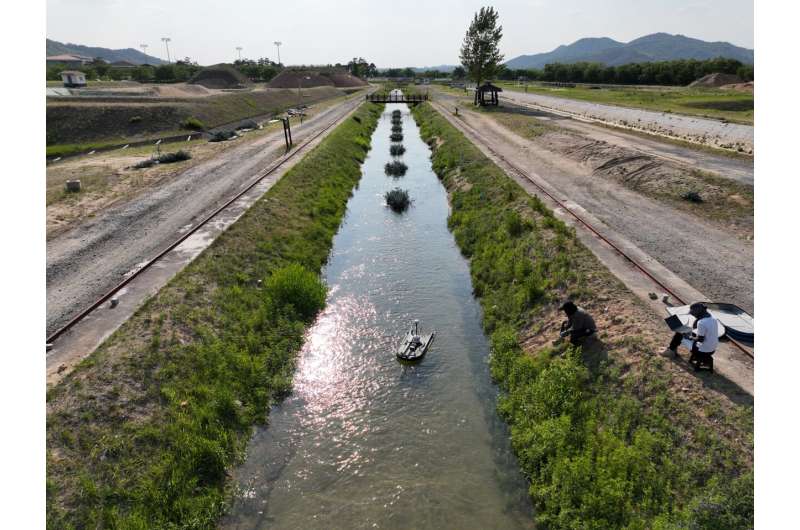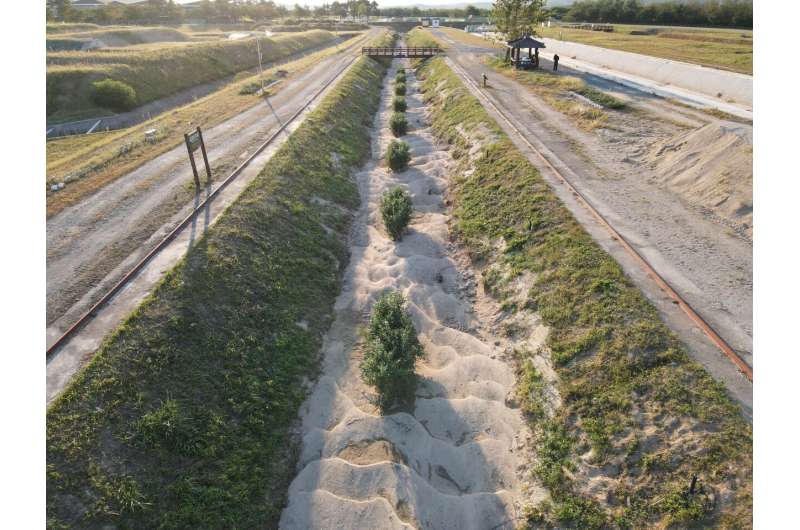This article has been reviewed according to Science X's editorial process and policies. Editors have highlighted the following attributes while ensuring the content's credibility:
fact-checked
trusted source
proofread
Leading-edge model predicts impact of river plants on flood level

River plants provide ecological and environmental benefits, but they raise flood risk by blocking the flow during heavy rain. Removing woody riparian vegetation patches is a primary flood prevention method, but it threatens stream's biodiversity. The research team at the Korea Institute of Civil Engineering and Building Technology (KICT) has developed a technology for quantifying the effect of river vegetation patches on flood level changes to aid in better decision-making of river management for balancing ecological benefits and flood mitigation.
The findings are published in the Journal of Hydrology.
Rivers have a complex physical shape that combines riverbed materials such as sand, gravel, and aquatic and riparian vegetation. Their shape may change over time due to the various flow patterns. Even if the amount of water flowing through the river is the same, the larger the degree of plant density in the river, the slower the flow rate and the higher the river level.
If the flow discharge is so small that it is unrelated to flood management, such river vegetation may have the advantage of providing various ecological services. However, during the flood season, excessive distribution of vegetation threatens the rise of flood levels, causing damage due to flood inundation.
Research on water level rise due to vegetation patches during floods has focused on quantifying flow resistance based on river plant shape and distribution. However, limitations in theoretical approaches and scaled-down lab data hinder using these findings for practical river vegetation management decisions.
The research team led by Dr. Ji Un, at the Department of Hydro Science and Engineering Research Division of KICT, presented a more explicit and accurate equation for calculating the vegetation flow resistance coefficient. This can accurately estimate the degree of flow resistance according to the physical characteristics of the vegetation patch and colony based on large-scale experiment dataset. The outdoor stream-scale experiment channel in KICT's River Experiment Center located in Andong was used to acquire dataset, and the experiments were performed based on highly accurate and precise hydrometry using natural-like vegetation.
Woody riparian vegetation typically clusters in patch form and increases flow resistance more significantly than individual plants. Therefore, Dr. Ji's study presented a robust relational equation that can directly calculate the flow resistance coefficient according to the blockage area or blockage factor of vegetation colonies and patches based on real-scale experimental data.

Dr. Ji said, "The study of vegetative channels and streams began in 2015 based on international joint research with Deltares in the Netherlands, and in particular, the study on the prediction of the flow resistance coefficient of vegetation patches in rivers was able to derive world-class results through a joint study with Aalto University in Finland."
She added, "More accurate predictions of the flow resistance coefficient of vegetation patches and colonies can greatly contribute to better solutions and explicit decision-making for river restoration and management projects based on natural-based solutions for flood prevention."
More information: Inhyeok Bae et al, Blockage effect of emergent riparian vegetation patches on river flow, Journal of Hydrology (2024). DOI: 10.1016/j.jhydrol.2024.131197





















